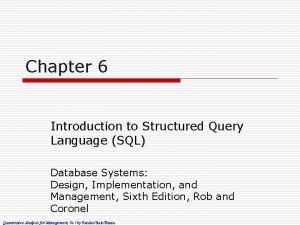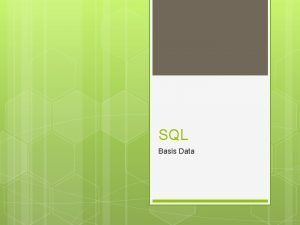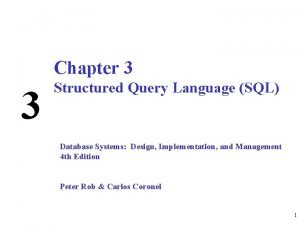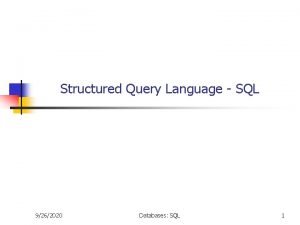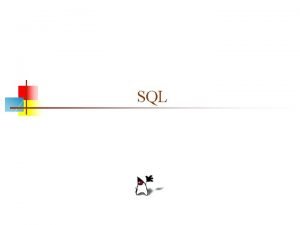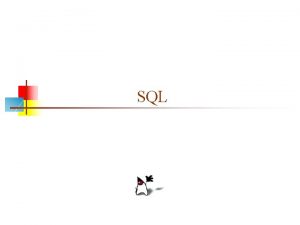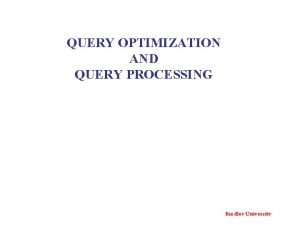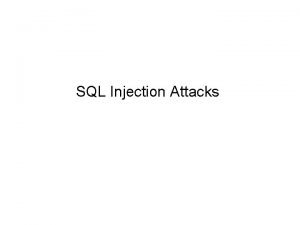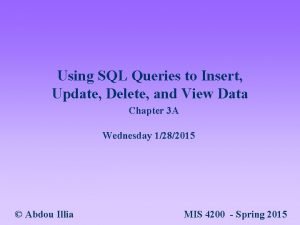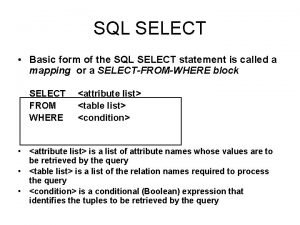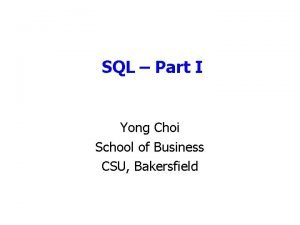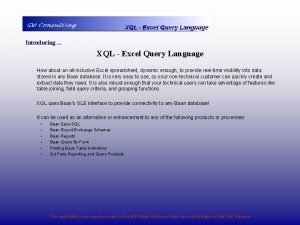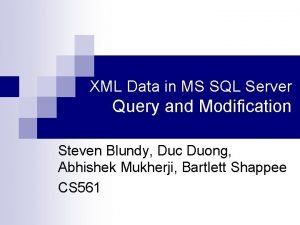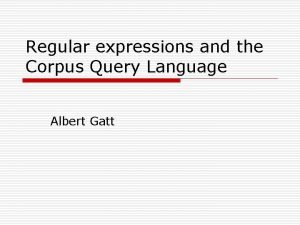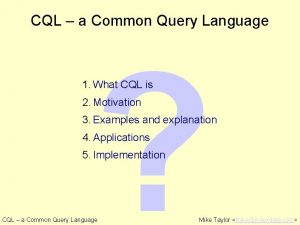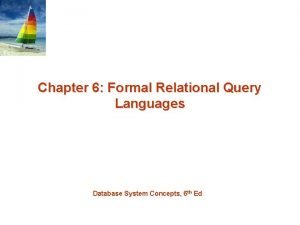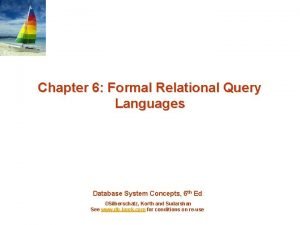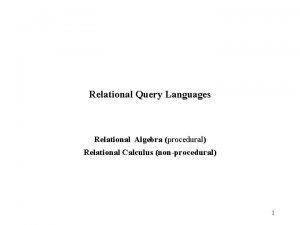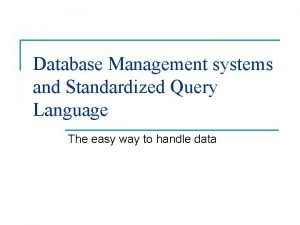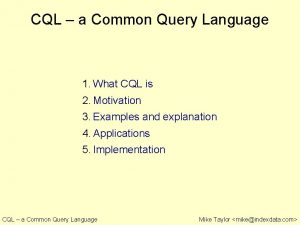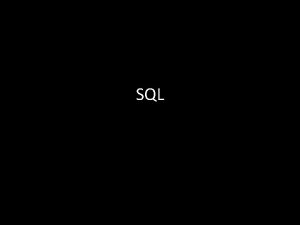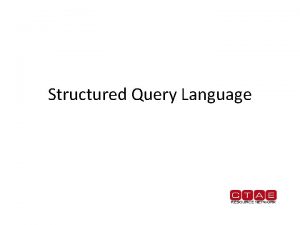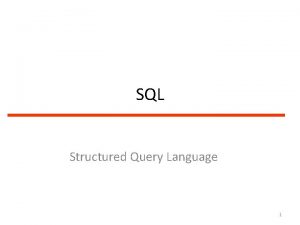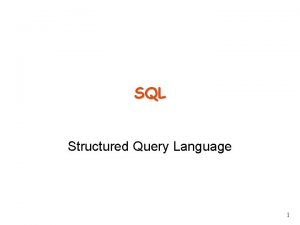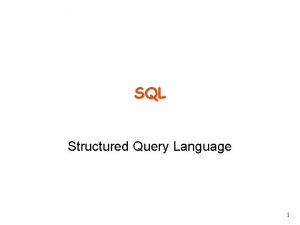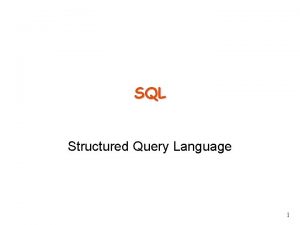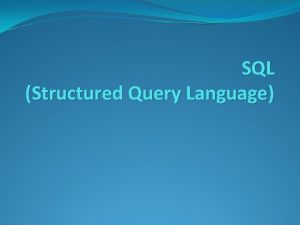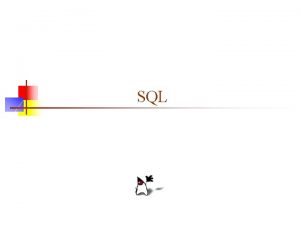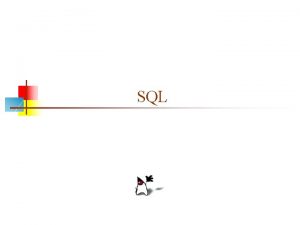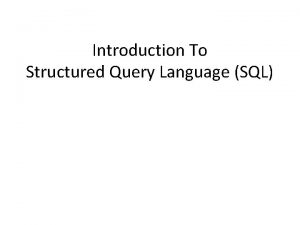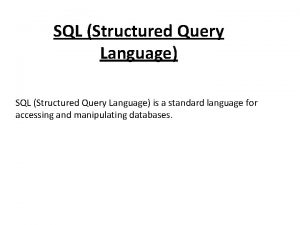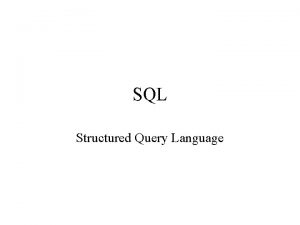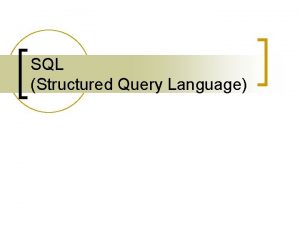SQL Structured Query Language SQL is a Standard







































- Slides: 39

SQL Structured Query Language

SQL is a Standard - BUT. . SQL is an ANSI (American National Standards Institute) standard computer language for accessing and manipulating database systems. SQL statements are used to retrieve and update data in a database. SQL works with database programs like MS Access, DB 2, Informix, MS SQL Server, Oracle, Sybase, etc. Unfortunately, there are many different versions of the SQL language, but to be in compliance with the ANSI standard, they must support the same major keywords in a similar manner (such as SELECT, UPDATE, DELETE, INSERT, WHERE, and others). Note: Most of the SQL database programs also have their own proprietary extensions in addition to the SQL standard!

SQL Database Tables A database most often contains one or more tables. Each table is identified by a name (e. g. "Customers" or "Orders"). Tables contain records (rows) with data. Below is an example of a table called "Persons": Last. Name First. Name Address City Hansen Ola Timoteivn 10 Sandnes Svendson Tove Borgvn 23 Sandnes Pettersen Kari Storgt 20 Stavanger

SQL Queries With SQL, we can query a database and have a result set returned. A query like this: SELECT Last. Name FROM Persons Gives a result set like this: Last. Name Hansen Svendson Pettersen

SQL Data Manipulation Language (DML) SQL (Structured Query Language) is a syntax for executing queries. But the SQL language also includes a syntax to update, insert, and delete records. These query and update commands together form the Data Manipulation Language (DML) part of SQL: • SELECT - extracts data from a database table • UPDATE - updates data in a database table • DELETE - deletes data from a database table • INSERT INTO - inserts new data into a database table

SQL Data Definition Language (DDL) The Data Definition Language (DDL) part of SQL permits database tables to be created or deleted. We can also define indexes (keys), specify links between tables, and impose constraints between database tables. The most important DDL statements in SQL are: • CREATE TABLE - creates a new database table • ALTER TABLE - alters (changes) a database table • DROP TABLE - deletes a database table • CREATE INDEX - creates an index (search key) • DROP INDEX - deletes an index

SQL The SELECT Statement The SELECT statement is used to select data from a table. The tabular result is stored in a result table (called the result-set). Syntax SELECT column_name(s) FROM table_name

To select the columns named "Last. Name" and "First. Name", use a SELECT statement like this: SELECT Last. Name, First. Name FROM Persons Last. Name First. Name Address City Hansen Ola Timoteivn 10 Sandnes Svendson Tove Borgvn 23 Sandnes Pettersen Kari Storgt 20 Stavanger výsledok Last. Name First. Name Hansen Ola Svendson Tove Pettersen Kari

Select All Columns To select all columns from the "Persons" table, use a * symbol instead of column names, like this: SELECT * FROM Persons Last. Name First. Name Address City Hansen Ola Timoteivn 10 Sandnes Svendson Tove Borgvn 23 Sandnes Pettersen Kari Storgt 20 Stavanger

The Result Set The result from a SQL query is stored in a result-set. Most database software systems allow navigation of the result set with programming functions, like: Move-To-First-Record, Get-Record. Content, Move-To-Next-Record, etc. Programming functions like these are not a part of this tutorial. To learn about accessing data with function calls, please visit our ADO tutorial.

Semicolon after SQL Statements? Semicolon is the standard way to separate each SQL statement in database systems that allow more than one SQL statement to be executed in the same call to the server. Some SQL tutorials end each SQL statement with a semicolon. Is this necessary? We are using MS Access and SQL Server 2000 and we do not have to put a semicolon after each SQL statement, but some database programs force you to use it.

The SELECT DISTINCT Statement The DISTINCT keyword is used to return only distinct (different) values. The SELECT statement returns information from table columns. But what if we only want to select distinct elements? With SQL, all we need to do is to add a DISTINCT keyword to the SELECT statement: Syntax SELECT DISTINCT column_name(s) FROM table_name

Using the DISTINCT keyword To select ALL values from the column named "Company" we use a SELECT statement like this: SELECT Company FROM Orders Company Order. Number Sega 3412 W 3 Schools 2312 Trio 4678 W 3 Schools 6798 Sega W 3 Schools Trio W 3 Schools

Note that "W 3 Schools" is listed twice in the result-set. To select only DIFFERENT values from the column named "Company" we use a SELECT DISTINCT statement like this: SELECT DISTINCT Company FROM Orders Company Sega Company Order. Number W 3 Schools Sega 3412 Trio W 3 Schools 2312 Trio 4678 W 3 Schools 6798

Select All Columns The WHERE clause is used to specify a selection criterion. The WHERE Clause To conditionally select data from a table, a WHERE clause can be added to the SELECT statement. Syntax SELECT column FROM table WHERE column operator value

With the WHERE clause, the following operators can be used: Operator Description = Equal <> Not equal > Greater than < Less than >= Greater than or equal <= Less than or equal BETWEEN Between an inclusive range LIKE Search for a pattern Note: In some versions of SQL the <> operator may be written as !=

Using the WHERE Clause To select only the persons living in the city "Sandnes", we add a WHERE clause to the SELECT statement: SELECT * FROM Persons WHERE City='Sandnes' Last. Name First. Name Address City Year Hansen Ola Timoteivn 10 Sandnes 1951 Svendson Tove Borgvn 23 Sandnes 1978 Svendson Stale Kaivn 18 Sandnes 1980 Pettersen Kari Storgt 20 Stavanger 1960 Last. Name First. Name Address City Year Hansen Ola Timoteivn 10 Sandnes 1951 Svendson Tove Borgvn 23 Sandnes 1978 Svendson Stale Kaivn 18 Sandnes 1980

Using Quotes Note that we have used single quotes around the conditional values in the examples. SQL uses single quotes around text values (most database systems will also accept double quotes). Numeric values should not be enclosed in quotes. For text values: This is correct: SELECT * FROM Persons WHERE First. Name='Tove' This is wrong: SELECT * FROM Persons WHERE First. Name=Tove

The LIKE Condition The LIKE condition is used to specify a search for a pattern in a column. Syntax SELECT column FROM table WHERE column LIKE pattern A "%" sign can be used to define wildcards (missing letters in the pattern) both before and after the pattern.

Using LIKE The following SQL statement will return persons with first names that start with an 'O': SELECT * FROM Persons WHERE First. Name LIKE 'O%' The following SQL statement will return persons with first names that end with an 'a': SELECT * FROM Persons WHERE First. Name LIKE '%a'

Using LIKE 2 The following SQL statement will return persons with first names that contain the pattern 'la': SELECT * FROM Persons WHERE First. Name LIKE '%la%'

SQL The INSERT INTO Statement

The INSERT INTO Statement The INSERT INTO statement is used to insert new rows into a table. Syntax INSERT INTO table_name VALUES (value 1, value 2, . . ) You can also specify the columns for which you want to insert data: INSERT INTO table_name (column 1, column 2, . . . ) VALUES (value 1, value 2, . . )

Insert a New Row Last. Name First. Name Address City Pettersen Kari Storgt 20 Stavanger And this SQL statement: INSERT INTO Persons VALUES ('Hetland', 'Camilla', 'Hagabakka 24', 'Sandnes') Last. Name First. Name Address City Pettersen Kari Storgt 20 Stavanger Hetland Camilla Hagabakka 24 Sandnes

Insert Data in Specified Columns Last. Name First. Name Address City Pettersen Kari Storgt 20 Stavanger Hetland Camilla Hagabakka 24 Sandnes And This SQL statement: INSERT INTO Persons (Last. Name, Address) VALUES ('Rasmussen', 'Storgt 67') Last. Name First. Name Address City Pettersen Kari Storgt 20 Stavanger Hetland Camilla Hagabakka 24 Sandnes Rasmussen Storgt 67

SQL The UPDATE Statement

The Update Statement The UPDATE statement is used to modify the data in a table. Syntax UPDATE table_name SET column_name = new_value WHERE column_name = some_value

Update one Column in a Row Last. Name First. Name Address City Nilsen Fred Kirkegt 56 Stavanger Rasmussen Storgt 67 We want to add a first name to the person with a last name of "Rasmussen": UPDATE Person SET First. Name = 'Nina' WHERE Last. Name = 'Rasmussen' Last. Name First. Name Address City Nilsen Fred Kirkegt 56 Stavanger Rasmussen Nina Storgt 67

Update several Columns in a Row Last. Name First. Name Address City Nilsen Fred Kirkegt 56 Stavanger Rasmussen Storgt 67 We want to change the address and add the name of the city: UPDATE Person SET Address = 'Stien 12', City = 'Stavanger' WHERE Last. Name = 'Rasmussen' Last. Name First. Name Address City Nilsen Fred Kirkegt 56 Stavanger Rasmussen Nina Stien 12 Stavanger

SQL The Delete Statement

The Delete Statement The DELETE statement is used to delete rows in a table. Syntax DELETE FROM table_name WHERE column_name = some_value

Last. Name First. Name Address City Nilsen Fred Kirkegt 56 Stavanger Rasmussen Nina Stien 12 Stavanger

Delete a Row Last. Name First. Name Address City Nilsen Fred Kirkegt 56 Stavanger Rasmussen Nina Stien 12 Stavanger "Nina Rasmussen" is going to be deleted: DELETE FROM Person WHERE Last. Name = 'Rasmussen' Last. Name First. Name Address City Nilsen Fred Kirkegt 56 Stavanger

Delete All Rows It is possible to delete all rows in a table without deleting the table. This means that the table structure, attributes, and indexes will be intact: DELETE FROM table_name Or DELETE * FROM table_name

Miscellaneous Commands • show databases; Slide 35 ▫ Show all the databases on the server • show tables; ▫ Show all the tables of the present database • show columns from table EMPLOYEE; • drop table t_name; ▫ Delete the entire table t_name • drop database db_name; ▫ Delete the entire database db_name • load data infile f_name into table t_name; ▫ To be discussed with the next homework.

DCL (Data Control Language) Commands • The rights or permissions assigned to user(s) to use some or all of Oracle objects are known as privileges. • Granting Privileges: It is used to assigning permissions to users. (Only DBA can assign) • Syntax: grant <permissions> ‘select, insert, delete, update • on <object_name> • to <username>; • Eg. grant insert on emp to user 1; user 1 can insert • grant all on emp to public; ‘assign all permissions to all users. ‘only

• Revoking Privileges: It get back permissions from the users. • Syntax: revoke <permission> on <object_name> from <username>; • Examples revoke all on emp from user 1; from user 1. ‘get back all permissions revoke select on emp from public; ‘get back select permission from all users.

TCL • (Transaction Control Language): It controls over transaction processing by specifying the beginning and ending of transactions. • Eg. Commit, Rollback to, Save point etc.

TCL Commands • Oracle treat a transaction as a single entity & incase of successful termination of transaction the changes are made permanent. The commands used with transactions are: • COMMIT: It ends the current transaction by saving database changes & starts a new transaction. Eg. commit; ‘i. e end or start a transaction • • • ROLLBACK: It ends the current transaction by discarding database changes & starts a new transaction. Eg. rollback; ‘i. e undo upto commit SAVEPOINT: It defines breakpoints or bookmarks for the transaction to allow partial rollbacks. Eg. savepoint P 1; ROLLBACK TO: Its undo up to given bookmark or breakpoint. Eg. rollback to P 1;
 Language
Language Introduction to structured query language (sql)
Introduction to structured query language (sql) What does sql stand for?
What does sql stand for? A structured query language – sql operators are
A structured query language – sql operators are Select * from tab
Select * from tab Update sql command
Update sql command Structured query language (sql) is an example of a(n)
Structured query language (sql) is an example of a(n) Sql n''
Sql n'' My structured query language
My structured query language Convert natural language to sql query
Convert natural language to sql query What is a standard language
What is a standard language Iterative vs recursive dns
Iterative vs recursive dns Query tree and query graph
Query tree and query graph Query tree and query graph
Query tree and query graph Types of interviews structured semi structured unstructured
Types of interviews structured semi structured unstructured How can we integrate oop with sd/sa ?
How can we integrate oop with sd/sa ? Online query optimizer
Online query optimizer An attacker injects the following sql query blah
An attacker injects the following sql query blah Hammerdb
Hammerdb Inside the sql server query optimizer
Inside the sql server query optimizer Whoisactive sql query
Whoisactive sql query Sql insert update delete query
Sql insert update delete query Shrpe
Shrpe Sql query
Sql query Cosmos db query optimization
Cosmos db query optimization Excel sql query
Excel sql query Sql query for xml
Sql query for xml Sql server intelligent query processing
Sql server intelligent query processing Object query language
Object query language Google data visualization api
Google data visualization api Corpus query language
Corpus query language Linq guernsey
Linq guernsey Common query language
Common query language Find the id name dept_name
Find the id name dept_name Google visualization playground
Google visualization playground Formal query language in dbms
Formal query language in dbms Relational query language
Relational query language Relational query languages
Relational query languages Standardized query language
Standardized query language Common query language
Common query language
